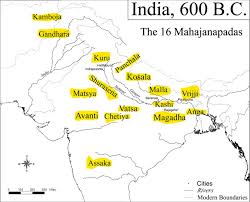What is the 16 Mahajanapada?
After the fall of the Harappans, there is no trace of the city until the Vedic period. People become villagers instead of cities. All these rural settlements suitable for human habitation are called townships. The word janapada literally means a specific area of a community. Gradually they grew in size and strength and emerged as a powerful single state. These are Mahajanapadas .
Sixteen such Mahajanapadas are mentioned in North India during the sixth and fifth centuries AD, around the time of the appearance of Gautama Buddha. In the Buddhist text called ‘Anguttaranikaya’, they are collectively called sixteen Mahajanapadas.
These 16 Mahajanapadas are :-
1) Kashi
2) Kosala
3) Anga
4) Magadha
5) Briji
6) Mallaa
7) Matsa
8) Vatsa
9) Chedi
10) Shursen
11) Asmak
12) Gandhara
13) Kuru
14) Panchal
15) Avanti
16) Kamboja

Notably, except Ashmak, the only fossils located in North India are Mahajanapada located in the south. It can be said that the Mahajanpadas originated by consuming relatively less powerful and smaller towns.
*Political system:
When it comes to ruling power, just as there was a monarchy, there was also a democratic Mahajanpada. For example, it can be said that Briji and Malla are counted as republics in ancient sources.
During this period, most of the states were monarchical, so the king was the supreme ruler of the state. It was not possible for the king alone to manage the administration of a large state. So they employed different types of bureaucrats for different jobs. They were called Mahamatr. The republican picture was somewhat different. In republics, one president or chief administrator was elected with the support of assembly or council. Their tenure was fixed.
*Economic and Social Life:
🔷 Agriculture : Increase in power or area in Mahajanapada also indicates growth in agriculture and agricultural sector. The area in which the Mahajanapadas were spread was favorable for agricultural production. Multiple rivers, ample rainfall and fertile land, these three factors make the Ganga valley full of agriculture.
Agriculture is described as one of the ‘ best deeds’ in Buddhist scriptures. A kind of crop called indigo is mentioned in Ashtadhyayi. It is nothing but blue. In Astadhyayi the spade is called Khanitra. Land wide enough for plowing was known as Ashtadhyayi te Suhli and unusable land was known as Ahli and land where plowing or plowing was difficult was known as Durhli. Among the crops, rice was the most important. The best rice was Shali. The land where it was cultivated was called Shaleya. Basically, paddy rice was cultivated by planting seedlings in seed beds. A portion of the agricultural produce was taken by the king. Its name is Bhag. The king was called shadhabhagi because he used to take one sixth of the produce. In Pali literature, small farmers were called kutumbikas and large land owners were called gahapatis. However, it should be remembered that the farmer is not a farmer by any means.
Just as agriculture was praised in Buddhist literature, another ‘noble action’ was cowherd or cattle rearing. Which is another important element of the economy of this era.
🔷 Industry : In addition to agricultural progress, many industrial activities and initiatives are seen in this age. People who worked on kanchi were called nalakara. Their associated villages were called Nalakar villages. Earthenware was an element of daily life. What the potters used to make was Krishna Chikkan Pottery or Black Pottery (NBPW: Northern Black Polished Ware). This pottery could not have been made without very good quality clay. They were made mirror-like by a coating, fired at a certain temperature.
A surprising development in technical production can be seen in the field of construction of iron materials. Commers or workers used to shoot this work. One such blacksmith was Chund, a devotee of Buddha.
.
Among the artisans we must mention Sutradhars who are called ‘Baddhaki’ in Pali. They used wood to build houses and furniture at that time. Tantubayas are also mentioned as weavers in Buddhist texts. Special artisans in making clothes were called Tunnabai, Suchikar etc. Also artisans of making ornaments also existed in that era. Those who used to make necklaces with precious stones like lapis lazuli or sapphire.
🔷 Currency : During this period, trade and commerce spread quite well and instead of exchange, the importance of currency became immense. Mobile bonis comparable to today’s hawkers
Some of the Sarths and their main people were called Sarthabah. A coin called ‘Kahapan’ or ‘Karshapan’ is repeatedly mentioned in Pali literature. Ancient Buddhist literature mentions three types of coins of gold, silver and copper called ‘Karshapan’. Silver coins are long, square and of various shapes. These were stamped or numbered coins.
It is believed that the coins of this era have been in circulation on the model of the ancient Hakkamenian ‘Sigloi’ coins of Iran.
🔷 Marriage : Eight types of marriage are mentioned in Dharmasutra texts. These are –
1) Brahmin marriage
2) Divine Marriage
3) Arya marriage
4) Butterfly marriage
5) Asura marriage
6) Marriage of Gandhara
7) Demon marriage
8) Ghost wedding
More post-> What is Permanent Settlement?
Frequently Asked :
1) From which ancient book is known about the sixteenth Mahajanpada?
A- From the Buddhist text called Anguttaranikaya.
2) What were the Mahajanapadas of South India in the 16th century?
A- Asmak was the only town located in the south.
3) What are the names of sixteen Mahajanapada?
A- Kashi, Kosala, Anga, Magadha, Briji, Malla, Matsa, Vatsa, Chedi, Shurasena, Ashmak, Gandhara, Kuru, Panchal, Avanti, Kamboja.
*Topics Covered :
16 mahajanapadas, 6 mahajanapadas map, 16 mahajanapadas name, 16 mahajanapadas with capital, 16 mahajanapadas name with capital, 16 mahajanapadas in map, 16 mahajanapadas and their kings, 16 mahajanapadas and their capitals
